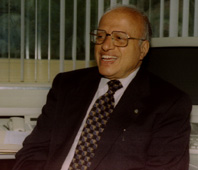


SCIENCE ACADEMIES' CAUCUS | ||
Dr. M.S Swaminathan, President, M.S. Swaminathan Research Foundation | ||

In July this year, a meeting of science academies of the world, mostly from developing countries, was held in Madras in India with generous support from FAO and the Government of Italy in order to articulate the scientific viewpoint on the issues before this Summit, I would like to highlight three points very briefly. First is science for sustainable agricultural progress. As we approach the new millennium, science and technology will have to help the over 400 million farming families to produce more food and other agricultural commodities under conditions of diminishing per capita land and water resources, expanding biotic and abiotic stresses and potential changes in climate, sea levels and ultraviolet-B radiation. At the same time, the higher productivity per units of land and water has to be achieved in a manner that the advances are environmentally and socially sustainable in addition to being economically viable. It is easy to add the prefix "sustainable" before agriculture, but it is very difficult to accomplish it at the grassroots level, unless there is a paradigm shift in agricultural research strategies and methodologies. Such a paradigm shift will involve participatory research with farm women and men on the one hand, and blending traditional and frontier technologies resulting in eco-technologies, on the other. The second issue relates to hidden hunger, agro-biodiversity and post-harvest technology. Over two billion children, women and men suffer today from hidden hunger caused by the deficiencies of micronutrients, like iron, iodine, zinc and vitamin A. Overcoming this serious problem, will involve concurrent action at three levels. These are, first, enlarging the food basket so as to include a wide range of nutritious grains like millets, amaranths, and chenopodium. Secondly, the revitalization of the on-farm conservation traditions, of tribal and rural families with reference to the cultivation of such grains, and thirdly, post-harvest processing so as to include grains rich in iron and other micronutrients in semi-processed and processed food. FAO in our view, should refer to such crops as nutritious grains and not as coarse grains as is being done at present. The calamity of micronutrient deficiencies can thus be converted into an opportunity for agro-biodiversity conservation, value addition during post-harvest processing and linking small-scale producers with the food processing industry. The final point, relates to information technology and fostering a learning revolution. There is a need for taking advantage of modern information technologies for promoting a learning revolution and reaching the unreached. Environmentally-benign technologies are knowledge-intensive and hence cost-effective methods of taking location and culture-specific information to rural families are urgently needed, using wherever appropriate, computer-aided extension systems. Several other suggestions are contained in the Madras Declaration. We urge the Director-General of FAO to organize a consultation on agricultural science policy and strategy for reviewing our suggestions and for recommending appropriate follow-up action to Member Nations. Such a consultation, obviously should include in addition to members from FAO, the Chairperson of the CGIAR, the Chair of the Science Academies Standing Committee, representatives of farmers' and women's associations and the NGO Forum, World Business Council, mass media and of UNESCO, UNEP, UNDP, UNICEF and IBRD. As we approach the end of the century, the breathing spell provided by the Green Revolution of the 1970s and 1980s for increasing food production above the rate of growth in population is also coming to an end. In our view, the target of reducing the number of children, women and men now going to bed hungry to half the present level by the year 2015 will remain an unfulfilled goal unless urgent attention is paid at the political level to a new scientific and learning revolution as well as to a population stabilization policy. | ||

 |